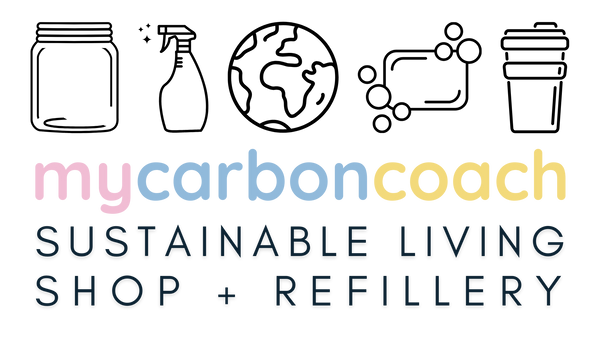
10+ Ways How To Build A Low-Waste Routine In 2025
Share
As we step into 2025, many of us are looking for ways to live more sustainably! One of the best and cheapest ways to do this is by reducing waste in our daily lives. The idea of going "zero waste" can feel overwhelming and I honestly don't think that zero waste is even possible or something we should be striving for, so the good news is that you don’t have to be perfect... small, consistent changes can make a big difference over time!
In this blog post, I’ll explore some practical steps to build a low-waste routine, from your morning habits to your shopping choices. Whether you're a sustainability newbie or looking to take your eco-friendly efforts further, this guide will hopefully help you make meaningful changes without the stress.
Morning: A Low-Waste Start To Your Day
1. Choose Reusable Over Disposable
Morning routines can be pretty waste-heavy, with everything from plastic toothbrushes to disposable coffee cups playing a role. Here’s how to make simple swaps:
- Toothbrush & Toothpaste: Swap out plastic toothbrushes for bamboo ones and try toothpaste tablets instead of tubes.
- Shaving: Ditch disposable razors and invest in a safety razor with replaceable blades.
- Skincare & Haircare: Look for bar soaps and shampoo bars instead of bottled products. Refills are another great alternative if you have a local refill shop (like mine in Taunton!).

2. A Low-Waste Coffee Or Tea Ritual
If you’re a tea or coffee lover, your morning drink can be a great place to reduce waste:
- Loose leaf tea instead of tea bags (many tea bags contain plastic!). This is coming soon to My Carbon Coach!
- Refillable coffee options like buying beans or ground coffee in bulk.
- A reusable coffee cup if you grab a drink on the go - many cafes even offer a discount for bringing your own.
At Work Or Out And About: Reducing Waste On The Go
3. Pack Your Own Lunch And Snacks
Takeaway food is often packaged in plastic, or if not then packaging that can't or won't get recycled, so preparing meals at home is a great way to cut down on waste.
- Use a stainless steel lunchbox or wax wraps instead of cling film.
- Choose reusable cutlery instead of disposable plastic ones.
- Keep a small, foldable tote bag in your bag to avoid needing a plastic bag.
4. Carry A Reusable Water Bottle
Single-use plastic bottles are one of the biggest sources of plastic waste, still. A reusable water bottle helps cut this out completely.
5. Make Your Commute More Sustainable
If possible, consider:
- Walking or cycling for short journeys.
- Using public transport instead of driving.
- Carpooling with colleagues to reduce emissions.
Shopping And Eating: Sustainable Choices
6. Reduce Food Waste
Food waste is a huge environmental issue, but small habits can make a big difference:
- Plan your meals ahead of time to only buy what you need.
- Store food properly using reusable containers to keep it fresher for longer.
- Use up leftovers in creative ways instead of throwing them away!

7. Shop Smart And Packaging-Free
Your weekly shop can generate a lot of waste, but making a few conscious choices can help:
- Bring your own jars and containers to refill staples like pasta, rice, and spices.
- Shop at farmers' markets or local shops that offer package-free options.
- Buy in bulk where possible to reduce the need for frequent packaging.
At my sustainable living shop, I offer refills for household and personal care products - bringing your own container helps eliminate plastic waste entirely!
Evening: Unwinding Sustainably
8. Eco-Friendly Cleaning Routine
Traditional cleaning products often contain harsh chemicals and come in plastic bottles. A low-waste routine can include:
- Refillable cleaning sprays instead of disposable wipes.
- Compostable sponges and wooden dish brushes instead of plastic-based cleaning tools.
- DIY natural cleaners made from vinegar, lemon, and bicarb of soda.
9. Sustainable Self-Care
Evening relaxation doesn’t have to come with waste:
- Use reusable cotton pads for makeup removal instead of disposable ones.
- Try solid cleansing bars instead of creams in plastic tubs.
- Swap plastic bath products for package-free soaps and bath bombs.
Long-Term Low-Waste Habits
10. Repair Instead Of Replace
Before throwing something away, see if it can be repaired:
- Learn basic sewing skills to fix clothes.
- Take electronics to repair cafes or specialists instead of replacing them.
- Try upcycling furniture or household items instead of discarding them.

11. Swap & Share
Buying new isn’t always necessary! Consider:
- Clothing swaps with friends or community groups.
- Borrowing books, tools, or equipment instead of buying.
- Using second-hand marketplaces like Vinted and Facebook Marketplace for clothes and furniture.
Final Thoughts: Every Small Change Counts
Transitioning to a low-waste sustainable lifestyle really doesn’t have to be all or nothing. Start with one small change at a time - switching to a reusable bottle, shopping with refills, or making your own cleaning products. Over time, these small steps will add up, making a big difference for the planet.
If you’re looking for practical ways to start your plastic-free journey, why not visit my sustainable living shop in Taunton! ! offer a range of eco-friendly swaps, from refills to reusable products, to help you on your journey to a greener 2025!
